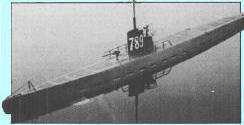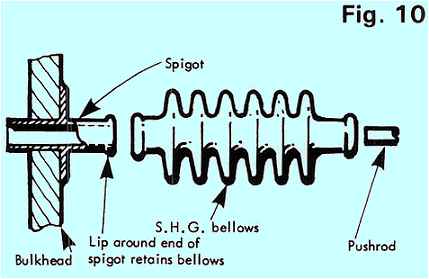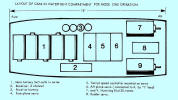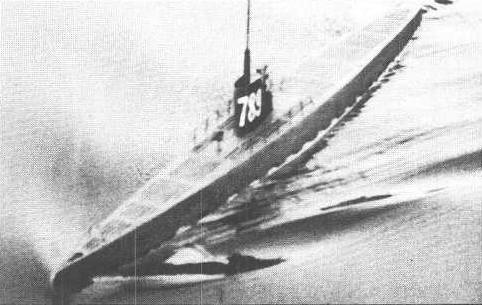|
U789
Part 2 - Kapitan Bill Thomas
|
|
Kapitan Bill Thomas reveals all about successful model
submarine
construction and operation.
|
|

|
The watertight compartment
Radio gear these days is of good quality in the main, but the radio is
only as good as the linkages. The rods need careful thought in this model,
which is fairly full of equipment, and they need careful routing to avoid
binding and chaffing. I used ball and socket joints throughout, these are
one of the greatest advances in model making since the introduction of the
left handed screwdriver in 1832. |
I used 1/8,in. diameter brass rods, Where these pass through the
bulkheads, rubber bellows by SHG were used, made for the job. I died a
little when I heard the price, about 75p each ( About £3.50 if you can
find them now-a-days - Mayhem ), but they really are very good. I coated
mine inside out with petroleum jelly On a routine cheek, I discovered that
one of them had slipped off its bulkhead spigot. I fitted a lip round it,
as shown, and the problem has not recurred. Fig. 10. |
|
 |
Finally on the subject of sealing the compartment, there is the main hatch
gasket. Initially, I used no gasket, just applied petroleum jelly to
the rim with a syringe, a-la cake icing. It never leaked a drop, but was a
little messy. I tried making a gasket from what I thought was cork
sheeting. It turned out to be micro thin cork facings on a core of paper.
I discarded it. Now I use a form of floor covering, 1/8in thick. Half the
thickness is a smooth black rubbery material, bonded to a layer of quite
dense plastic foam. There is nothing special about it, there is no
trademark or anything, so I fear I cannot specify exactly what you should
seek. I have seen very similar material in shops, though faced with
decorative colours and patterns, (Lino Vinyl?! - Mayhem).
|
|
I have mentioned acrylic sheet, for the hatch cover, I
usually think of it as Perspex. It is funny stuff. It is brittle, and has
poor resistance to shear and torsion stress. You have to be careful when
working it. However, its compressive strength, which is what interests us,
is adequate. Moreover, it is transparent; you can see what is going on
inside the boat. When I laid up the glass fibre (GRP - Glass Reinforced
Plastic - Mayhem) for the hull, I also prepared sheets of GRP for
the hatch rim and bulkheads, but acrylic sheet could also be used for
these. |
The vent tube, whose primary function is for blowing down, so that the
boat can be checked for leaks, or if the bilge tube plug is removed, for
expelling water, also has a secondary function. The tube I used, silicone
tube, 1/8in bore, also houses the receiver aerial, which is thus kept dry.
It can be clipped to the hatch top, or led up through into the conning
tower, depending on which position gives the best range. Long radio range
with these boats is not too important. Even at surface trim they tend to
blend in to the background with their low profile and grey finish. You
probably won't want more than 60 yards or so range. |
At this stage I would like to record my appreciation of the ideas and
suggestions that have cropped up from my club colleagues, the aerial idea
just mentioned is such an idea. However, the next guy who suggests that I
should motorise my 6BA tubular spanner for bolting down the hatch cover
may come to a sticky end. (The 43 nuts take 4 1/2 minutes to bolt down, 2
1/2 minutes to take off). |
The advantages of being a member of a club when tackling awkward projects
are manifest. I have the honour to be an Honorary Member of Tynemouth Boat
Club, established 1893, and I have found that if you have a technical
query, there is almost always somebody who can shed light on it, or who
knows someone who can. I know there are loners, who stay away from clubs
because they feel they may be regimented or over controlled, but I think
they miss out on a lot, in all sorts of ways.
|
|

Layout of watertight box - Mode 1 |
Mode 1
It is unnecessary for a submarine to be trimmed down from surface
trim to diving trim in, provided there is a strong enough flow of water
over the planes to enable them to exert enough effort to overcome the
buoyancy of the model, and thrust it under the surface. The method has the
merit of simplicity to commend it. I fitted a pair of Hummingbird 20
motors, honourably retired from front line service in my fast electric
boats, but still with plenty of life. To drive them, I supplied 6 'D'
cells (4 amp/hr) in series, giving a voltage of 7 volts. 35mm 3 Blade
Graupner props were used. Ten amp micro switches controlled the set up.
Three channel radio was used; one for steering, one for switching the
motors, and one for the aft panes. The front (or as we experts say, the
'fore') planes were not radio controlled, but could be locked in any
desired angle by 4BA socket head grub screws long. 1 hoped to find what
the optimum angle was, and then leave it. Gibbering with excite merit, I
placed the boat in the water, and switched on. |
|
The boat tore across the water like a scalded cat. I applied dive to the
planes, the bow dipped, the boat attempted to dive, but changed its mind
and tried a slow roll instead, despite the contra‑rotating props, then it
gave up and lay helplessly on its side with one propeller threshing
uselessly out of the water. Part way through the sub merging process on a
submarine, the centre of gravity and the centre of buoyancy momentarily
coincide and the boat is unstable. Normally the boat goes through this
condition without disaster. A C-of-G which is correct on the surface
may not be correct during diving, as I discovered. Screeches of hilarity
from my loyal mates rang out. Strong men fell down, helplessly convulsed
with laughter. I ran behind the clubhouse and wept bitterly. |
Later, chewing my anti‑stress tablets thoughtfully, 1 diagnosed the causes
of the disaster. The boat was too powerful. The motors needed controlling.
The centre of gravity was not low enough. |
|
I removed one of the cells, reducing the voltage to 6v. I fitted a Tamiya
speed controller, a straightforward wiper job the car people use a lot,
and I flitted a block of lead (21bs.) into the keel. 1 am somewhat
prejudiced against speed controllers, having seen them proved unreliable
and wasteful of power. To be fair, the Tamiya product was well made and
proved infallible during the period when I used it. It did heat up, and in
the restricted space inside the watertight compartment, it warmed the air,
with the effect of pressurising the boat slightly, as indicated by a very
slow succession of small bubbles which emerged from one of the propeller
tubes after 10 minutes or so. The result was, very little water entered
the boat. Using a small medical type syringe, I rarely sucked more than
3ccs of water out of the bilge after a 25 minute run. On the debit side,
there was condensation, which on balance is probably more likely to affect
radio gear than actual seepage of 'solid' water as opposed to a 'mist'
type dampness. I did not however experience any radio problems, The rudder
servo, if mounted between the couplings, needs protection from fine spray
thrown off by centrifugal force.
|
|
With this Mode 1 format, I progressed steadily At first, I had the planes
set far too coarsely. This did not show up to a great extent when diving.
Incidentally, when Your boat slithers under the
surface for the first time, taking with it all that precious gear that you
can't really afford, you may feel that this is one of the more
interesting' moments in your modelling life, followed by the moment when
it surfaces for the first time. U789 initially used to surface
in the most dramatic manner. leaping out of the water for nearly half its
length rather like a Polaris (the missile not the sub). On one occasion,
distracted for an instant, I lost sight of the boat. I panicked. It was a
brisk mover, it could go a long way in a short time, or get well and truly
entangled in weeds, I might never find it. I applied full power and put
the planes to surface. I screened the lake, and took a quick swig of nerve
tonic. Nothing. Then, about 4 feet away, U789 did its 'Jaws' act, leaping
half out of the water literally under the nose of a small infant
peacefully fishing. She squawked in terror, and fell down backwards. Her
net went one way, and her jar, which contained about 24 million
sticklebacks, toppled into the pond, doubtless to the relief of said
sticklebacks. The male parent was adjacent. He was the human equivalent,
at a rough estimate, of a heavy cruiser, and I was clearly outgunned. He
advanced. I picked the kid up, gabbling profuse apologies. However, heavy
cruiser was not hostile. He thought U789 was fantastic. He soothed his
little daughter. When they had gone, I swaggered arrogantly into the
clubhouse, "Ho! Ho!" Did you see the clever way I made it look like in
accident?" I said. That's what you've got to have, when you're in
submarines, like me. Charisma!
|
|
Later, after a few Phyllosans (??? - Mayhem), I reviewed the state of the
game. Using a 'Y' lead con connected to another servo, I hooked up the
front planes. Thus I had two sets of planes working off one channel. It
could be done using only one servo with one very long linkage. However, I
do not like long linkages, especially in a congested hull. I drastically
reduced the movement of the aft planes down to a total of about 1/8 in.
The aft planes, though smaller than the, fore planes, are much more
sensitive placed as they are directly behind the propellers. The fore
planes required a much coarser movement, about 25 degrees each side of
neutral. Control improved, diving and surfacing were easy. Constant depth
keeping was very hard. The boat, like, all conventional submarines, was
not designed, and was the wrong shape, for good underwater performance
especially at the high speed required to keep U789 under the surface.
These boats probably spent about 90% of their time on the surface in order
to cover the often long distances to their patrol areas. A boat is either
very good under water or very good on the surface.
|
I don't think you can be excellent at both, Nuclear submarines, with their
roughly cylindrical shape, are ideal for almost permanent travel under
water. On the surface I bet they are pigs to handle. So U789 had a
problem, At slow speeds, when it might be more manageable submerged, it
would not stay submerged. It had too much buoyancy. All the. time it was
fighting to get back to surface trim. There was disharmony. The other,
major snag, was the poor endurance. |
The two Hummingbird 20's were very greedy, and after about 25 minutes of
non-stop diving and attempts at depth keeping, the battery pack showed
signs of tiredness. When this happens, the boat should be stopped
forthwith. There is no future in bashing your meads. If you stop for a
chat, with the boat stopped now and again, unjust mosey round on the
surface at half speed, the endurance stretches out to just over an hour or
even more, as the battery recuperates during rests. But this was not for
me. To me, a submarine should spend most of its time where it belongs,
underneath. |
|
Round about this time, I received a most humiliating
experience. I was accompanying U789 round the lake, chewing nerve pills,
juggling the sticks, and perspiring freely, and I was joined by Lieutenant
Martin Young. whose own Type IX U boat was nearing completion at this
stage. He is an accomplished aero modeller. He watched for a minute or
two, by which time I was a cursing demoralised wreck. I readily handed him
the transmitter on request. After about half a minute of sussing out the
system he dived the boat. What is more, he kept it dived. Eventually,
about 80 yards up the lake, the boat hit something, lost speed and
surfaced. The longest underwater trip I had achieved was about 30 yards.
Needless to say, I was totally consumed
with jealous rage and fury. I tried to hit him with my plastic binoculars,
but my eyes were full of tears and my aim was poor. He went off, laughing.
I recovered, after a long pull at my flask of Wincarnis (??? - Mayhem),
and felt goaded into trying harder, eventually with some success. But that
boat was tricky, submerged. Something had to be done to improve the
endurance, and the submerged handling. On the surface, U789 was lovely,
and still is. Tynemouth lake is about 70 yards from the North Sea, and
about 70 feet above it. It gets rough when the wind is in the north, and
it is no place for fair‑weather models. When its rough, its a waste of
time diving the boat, you simply can't see it, but it's great motoring
around on the surface. The boat sticks its long slim bow into the chop
with surgical ease. No big bow wave or clouds of spray. When other models
of similar weight (101bs.) are 'stetting' around like ping‑pong balls, U789
cruisers around with what looks remarkably like disdain.
|
|

U789 in calm conditions,
seldom seen on Tynemouth lake.
She generates an impressive bow wave as she majestically glides through
the water.
(All photos by the author.)
|
|
Competition Time
During the trials of U789, I entered a Club Scale Competition, for
steering. The turning circle of the boat was about 20ft., which I was
completely unused to. As a result, by the time I was halfway round the
course, it was clear to myself and everyone else that I was making what we
experts call a 'bally‑toot' of the job. Unable to stand the shame any
more, I dived the boat, and after a plausible interval, surfaced near the
landing stage, in what I felt was a very good attempt at cheating. I
claimed that I had negotiated the rest of the course faultlessly, below
the surface, and I claimed the appropriate points. Raucous screeches of
delight greeted this claim, and the judge laughingly disqualified me,
despite my tears and the tantrum I laid on. I sulked and darted venomous
glances at various people, but nobody noticed, so I swallowed a few anti
depression tablets and went off to sail the boat on my own. Some weeks
later, I had more or less got the hang of steering the boat, and I entered
another of these steering competitions. The 5in beam enabled you to go
through the gates at angles you would never normally consider, and the
boat motored through the chop and stuck a couple of clear rounds in. This
was enough to win the competition. I loaded my boat and the rest of the
gear into my car, and checked that the engine would fire first time. Then
I swaggered back to the clubhouse. They were drying their models, and
clearing up. I positioned myself just inside the entrance, and intoned the
following remarks:
|
"Kameraden, please try not to feel too devastated and inferior as a
result of the crushing, humiliating defeat U789 has just inflicted
so convincingly upon you all! It is no disgrace to be thrashed by U789!
You all struggled to the best of your limited ability, with your crude,
primitive boats, and it is not your fault that you were annihilated by the
highly sophisticated, superbly designed U789 which incorporates the most
overwhelmingly brilliant technology, not to mention my own dazzling
navigational skills! I hope you will all persevere, even in the face of
the invincible display of genius I have arrayed before you! It would be
appropriate, when you wish to speak to me, to stand to attention, and
address me as 'Herr Kapitan' "... At this stage, they rushed at me with
the intention of removing my trousers. But my escape had been too well
thought out, and I was off like a shot. That's how we U Boat Commanders
are. Schemers, crafty as a barrow load of weasels. I was in the pub, and
halfway through my second Ribena before they started trickling in." |
|

Fore and aft planes setup. |
|
Manoeuvrability
The original turning circle of U789 was about 20ft., and I
found this a little tedious. I had installed the prop shafts well apart,
so that I could fit large propellers if needed, As a result the prop wash
missed the centrally located rudder to a large extent, causing a poor
turn. Learning from my mistake, the builder of the next Type IX to appear
at the lake, Martin Young, installed the prop shafts as close together as
possible as the 30mm dia. propellers would allow, which is quite close.
His turning circle was 1Oft., a considerable improvement. Stung by this, I
fitted twin rudders to U789, and this tightened the turn to about 1Oft.
also. I was reasonably content with this until Herr W. Carpenter, who
commands a large Type VII U Boat, also at Tynemouth, demonstrated his
independent motor control. With one motor astern and one forward, the
model slowly spun in its own length. If I hadn't seen it I wouldn't have
believed it. My lower lip trembled. I only had 4‑channel gear.
But I fought back the tears and pretended I wasn't
impressed. How could I compete with this? It is an easy matter
to enhance a turning circle by having the rudder servo cut out one of the
motors. I wondered if it is possible with a little skulduggery, not only
to stop a motor this way, but to reverse it. I bet it could be done. Three
functions for the price of one! I smiled happily, and started U789 into a
mock attack on a 575 (Model yacht), He saw the periscope, and spun out of
the way, with a harsh cackle of triumph. My smile was replaced by a scowl.
These tea‑drinking Englanders, they think they
are so clever. I wonder if I could get U789 to lay a minefield. I bet I
could. I chewed my Iron Jelloids thoughtfully.....!
|
|
Back to U 789 index
Home
|




